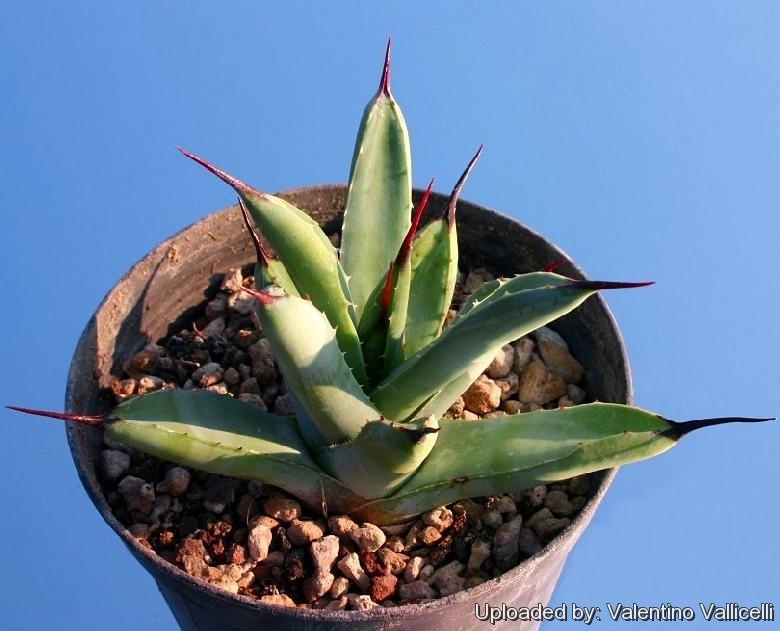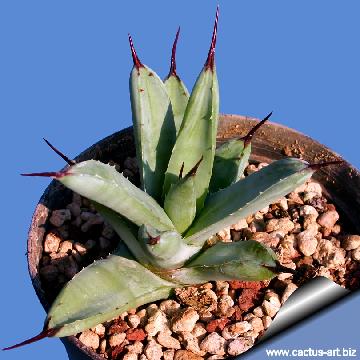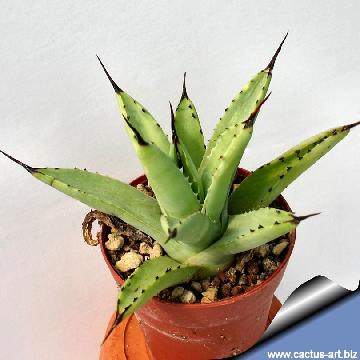Accepted Scientific Name: Agave macroacantha Zucc.
Nova Acta Phys.-Med. Acad. Caes. Leop.-Carol. Nat. Cur. 16(2): 676. 1833

Agave macroacantha ''viridis''
Agave macroacantha ''viridis''
This small and elegant, spherical clumping agave forms, 30 cm rosettes composed of, stunning narrow leaves tipped with an impressive black-brown spine. The so called forma ''viridis'' has paleer glaucous /yellowish/green leaves (while the standard form has powdery blue leaves)
Origin and Habitat: Mexico ( Oaxaca and near Tehuacan in Puebla)
Habitat: Grows in barren rocky and very arid terrain where it grew with Cephalocereus hoppenstedtiiSN|6711]]SN|6711]], Neobuxbaumia tetetzoSN|6411]]SN|6411]] and a Mammillaria sp. at 1500-2000 m.
Synonyms:
See all synonyms of Agave macroacantha
back
Accepted name in llifle Database:Agave macroacantha Zucc.Nova Acta Phys.-Med. Acad. Caes. Leop.-Carol. Nat. Cur. 16(2): 676. 1833Synonymy: 21
back
Description: Agave macroacanthaSN|516]]SN|516]] viridis is distinguished from the standard greyish-blue Agave macroacanthaSN|516]]SN|516]] for its greener foliage, however the two plants are quite similar and it is hard to tell apart one from the others, if not for the foliage colouration.
Habit: This is a very distinctive small to medium-sized stemless or short-stemmed Agave, it forms, neat, compact, rosette composed of many narrow leaves. It forms dense clumps apparently generated by the multiplication of ground-level offshoots to nearly 60 cm tall by 150 cm wide comprised of 25 to 35 inch wide rosettes.
Leaves: Bluish-green, straight, dagger-like, evenly spaced that radiate straight out from the centre of the plant, up to 55 cm long (but usually not more than 15-30 cm) with a thick, stiff, prominent, straight or undulate, rounded below, 3 cm long terminal spine (white/brown) dark brownish-red to almost black) . The margins of the leaves are very straight (or some time undulate) and have short, contrasting dark brown, serrated teeth 0,5-2,5 cm apart.
Flowers: The inflorescence is made up of a 2 metre slender stem with 10 to 14 lateral branches which hold groups of purple-tinged green flowers with a fuzzy interior flowers. Often after the flowering there appear small bulbils (already formed tiny plants) which fall to the ground, giving life to a new colony of Agaves. When this plant begins to flower the centre leaves take on an attractive reddish hue from where the dark red inflorescence begins to emerge
Blooming season: Spring to summer. The species does not flower as freely as some, the plant needs to be 15 years or better to flower.
Subspecies, varieties, forms and cultivars of plants belonging to the Agave macroacantha group
 Agave macroacantha Zucc.: forms clumps to 60 cm by 1.5 m composed of bluish grey rosettes. Leaves sword-shaped to 35 cm long with black spines at the tips. Distribution: Oaxaca and Tehuacan in the State of Puebla.
Agave macroacantha Zucc.: forms clumps to 60 cm by 1.5 m composed of bluish grey rosettes. Leaves sword-shaped to 35 cm long with black spines at the tips. Distribution: Oaxaca and Tehuacan in the State of Puebla. Agave macroacantha viridis hort.: has a bluish-green leaves, but it is hard to tell apart it from the stand species, if not for the foliage colouration.
Agave macroacantha viridis hort.: has a bluish-green leaves, but it is hard to tell apart it from the stand species, if not for the foliage colouration.
Bibliography: Major references and further lectures:
1) J. Thiede: “Agave macroacantha.” In: Urs Eggli “Illustrated Handbook of Succulent Plants: Monocotyledons: Monocotyledons” Springer Science & Business Media, 17/Jul/2001
2) Park S. Nobel “Environmental Biology of Agaves and Cacti” Cambridge University Press, 16/Oct/2003
3) Wikipedia contributors. "Agave macroacantha." Wikipedia, The Free Encyclopedia. Wikipedia, The Free Encyclopedia, 30 Jan. 2014. Web. 4 Nov. 2014.
4) Gentry, Howard Scott. "Agaves of Continental North America." University of Arizona Press, Tucson, 1992.
5) San Marcos Growers contributors “Agave macroacantha - Black-spined Agave ” San Marcos Growers <http://www.smgrowers.com>. Web. 27 Sep. 2014.
6) Mary and Gary Irish “Agaves, Yuccas, and Related Plants: A Gardener's Guide” Timber Press, 2000
7) August J. Breitung “Agave macroacantha”. In: “The Agaves.” The Cactus & Succulent Journal Yearbook, 1968
8) T. Heller “Agaven.” Münster 2006 .
9) W. Trelease “Agave macroacantha and allied Euagaves.” In: Annual Rep. Missouri Bot. Gard. 18: 231–256 1907
 Agave macroacantha viridis Photo by: Cactus Art
Agave macroacantha viridis Photo by: Cactus Art Agave macroacantha viridis Photo by: Cactus Art
Agave macroacantha viridis Photo by: Cactus ArtCultivation and Propagation: Agave macroacanthaSN|516]]SN|516]] (Black-spined Agave) is a stunning specimen plant for containers. In milder climates this plant grows well outdoor in full sun (Light shade or eastern exposure in hot areas), plant in deep well drained soil where the climate is suitable ( coastal zones and islands). The plants in pot tend to be slow grower, but worth the effort.
Growth rate: Agave macroacanthaSN|516]]SN|516]] is relatively slow growing, taking several years to reach flowering size.
Soil: Plant in well-drained soil. It is better to use wide pots which allow space for the roots of the Agave macroacanthaSN|516]]SN|516]] to grow.
Repotting: Every two years the pots should be changed, shortening the roots and eliminating the buds which suck the goodness from the plant, limiting its growth.
Exposure: Full sun or light shade or eastern exposure in hot low desert areas.
Waterings: Water thoroughly when soil is dry to the touch. In winter watering this plant can be done once every 1-2 months, there is no need to mist the leaves. The blue-and blue-gray-leaved forms are from very arid areas, and once established in ground the plants should be kept dry to prevent any potential rot. The blue-green-leaved form is from slightly more moist areas, and will tolerate extra water.
Hardiness: Agave macroacanthaSN|516]]SN|516]] can tolerate nighttime air temperatures of -6°C when droughted but not if watered and it is best to avoid severe freezing temperatures.
Heat Tolerance: Excellent.
Propagation: Agave macroacanthaSN|516]]SN|516]] can sexually reproduce by seeds and propagate vegetatively by aerial bulbils and ground-level basal shoots and rhizomes. It suckers, but not an aggressive spreader in the garden. Remove the basal suckers in spring or summer and let the cuttings dry for a few days before inserting in compost. The only problem is the logistics of getting to the suckers - very sharp spines and suckers usually right up against, or underneath the mother plant.
Uses: These striking plants are wonderful when used for accent or simply to provide some all year round foliage colour and often used in a pot as a patio plant, they make an eye-catching statement and along with other evergreen plants in pots, can be moved around to change the scenery or position to give more shelter.













